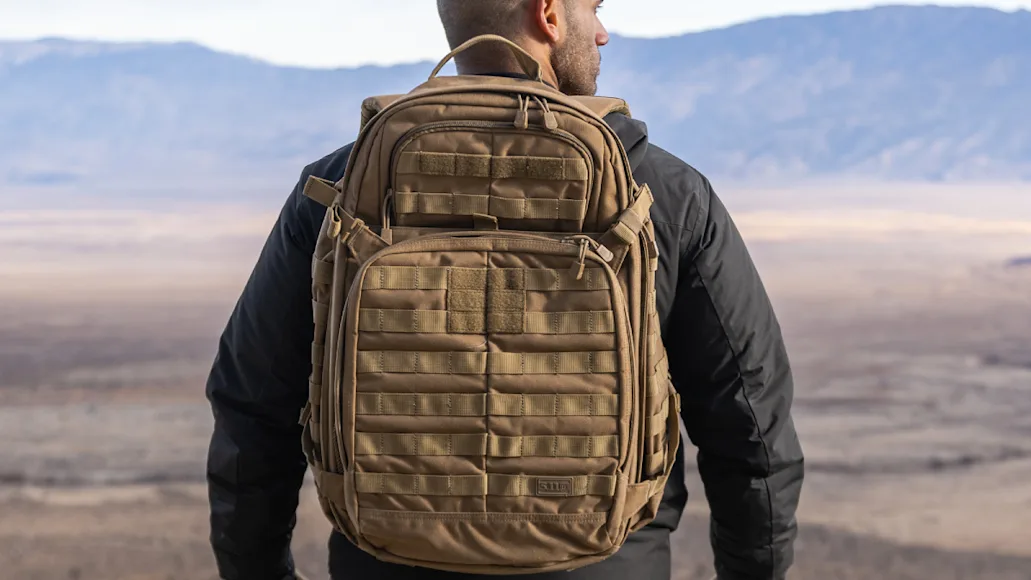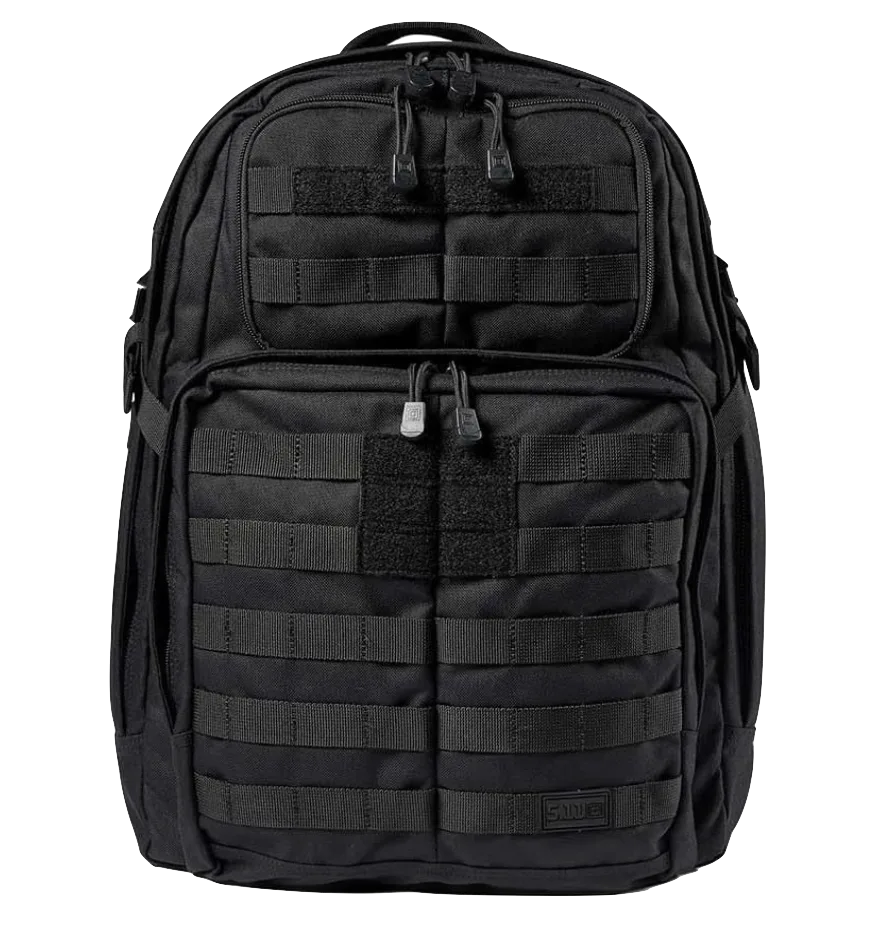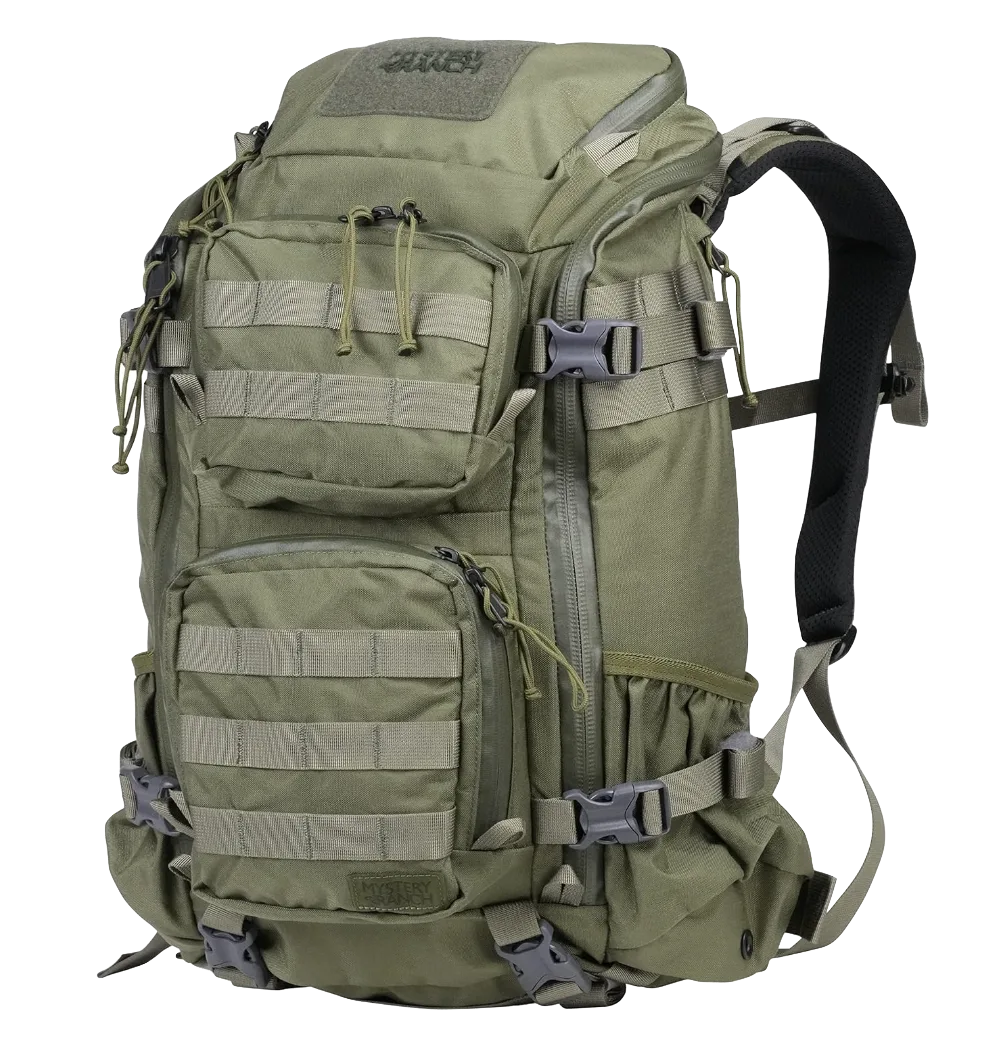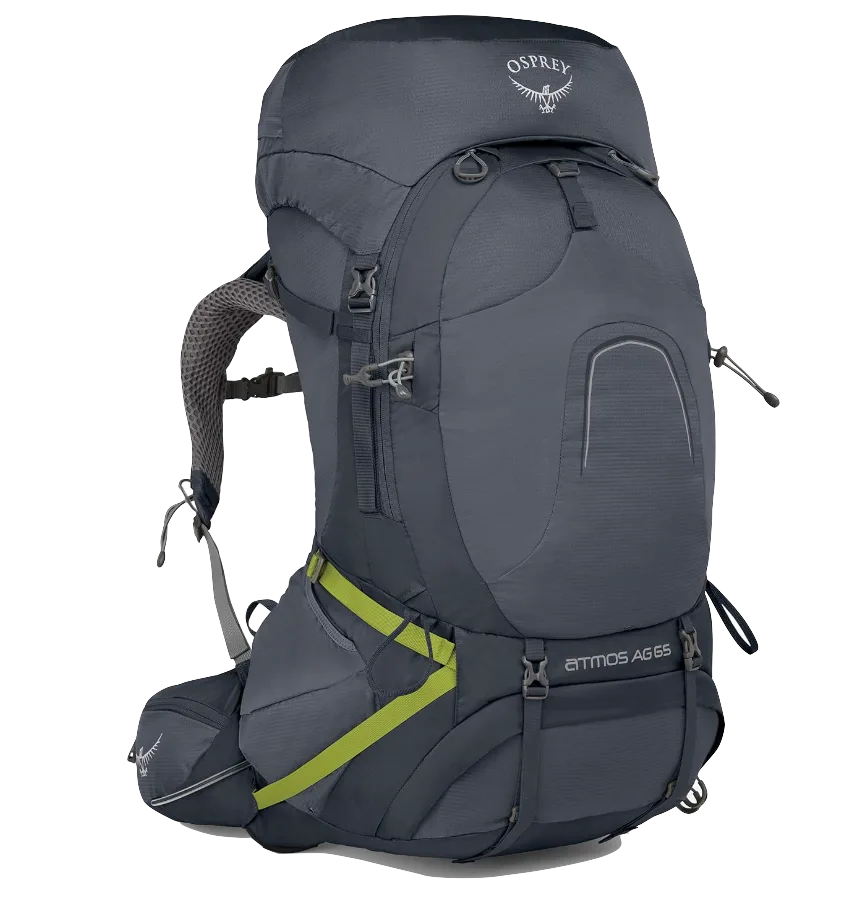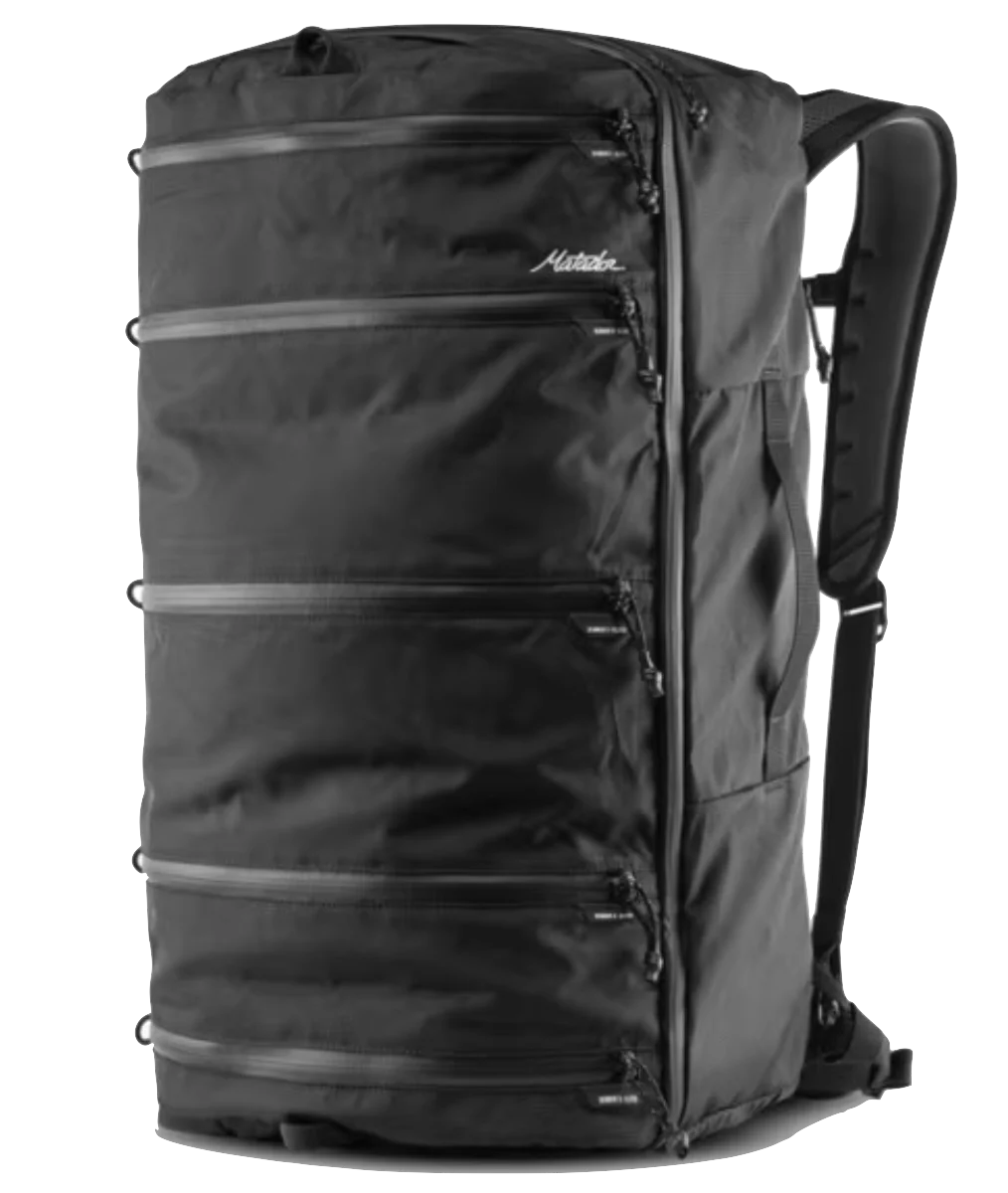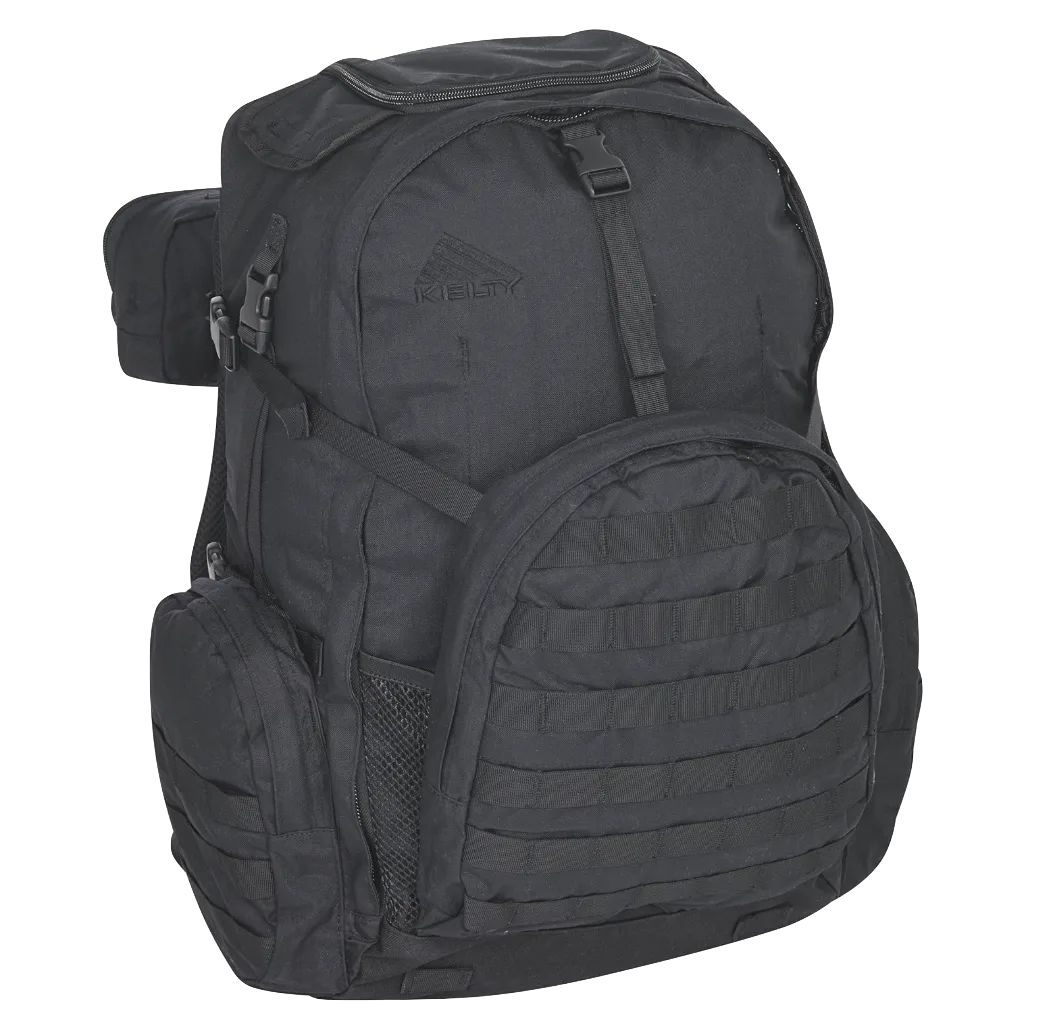We may earn revenue from the products available on this page and participate in affiliate programs. Learn more ›
We’ve lived through a lot of history over the past several years. If we’ve learned anything from the experience, it’s that the world is a crazy and often unpredictable place. Being prepared used to be something only our tinfoil-hat-wearing neighbors worried about. However, having a survival backpack on hand just in case the proverbial poo hits the propeller is just plain practical these days.
There’s a huge difference between the average day pack and one that could literally save your life in an emergency. If you aren’t sure what to look for, we’ve tested and reviewed some of the best survival backpacks being made today to make your decision a whole lot easier.
Best Overall: 5.11 Rush 24 2.0
Most Durable: Mystery Ranch Blitz 30
Best Small Pack: 5.11 Rush MOAB Sling Pack
Best Large Pack: Osprey Atmos AG 65
Best Waterproof: Matador SEG45 Travel Pack
Best With Extra Compartments: Kelty Tactical Raven 2500
Most Functional: Deuter Futura Pro 36
How We Picked the Best Survival Backpacks
With thousands of different backpacks available—including models optimized for hunting, EDC, travel, and tactical applications—finding the best survival backpack for your emergency preparedness needs can feel more than a little overwhelming.
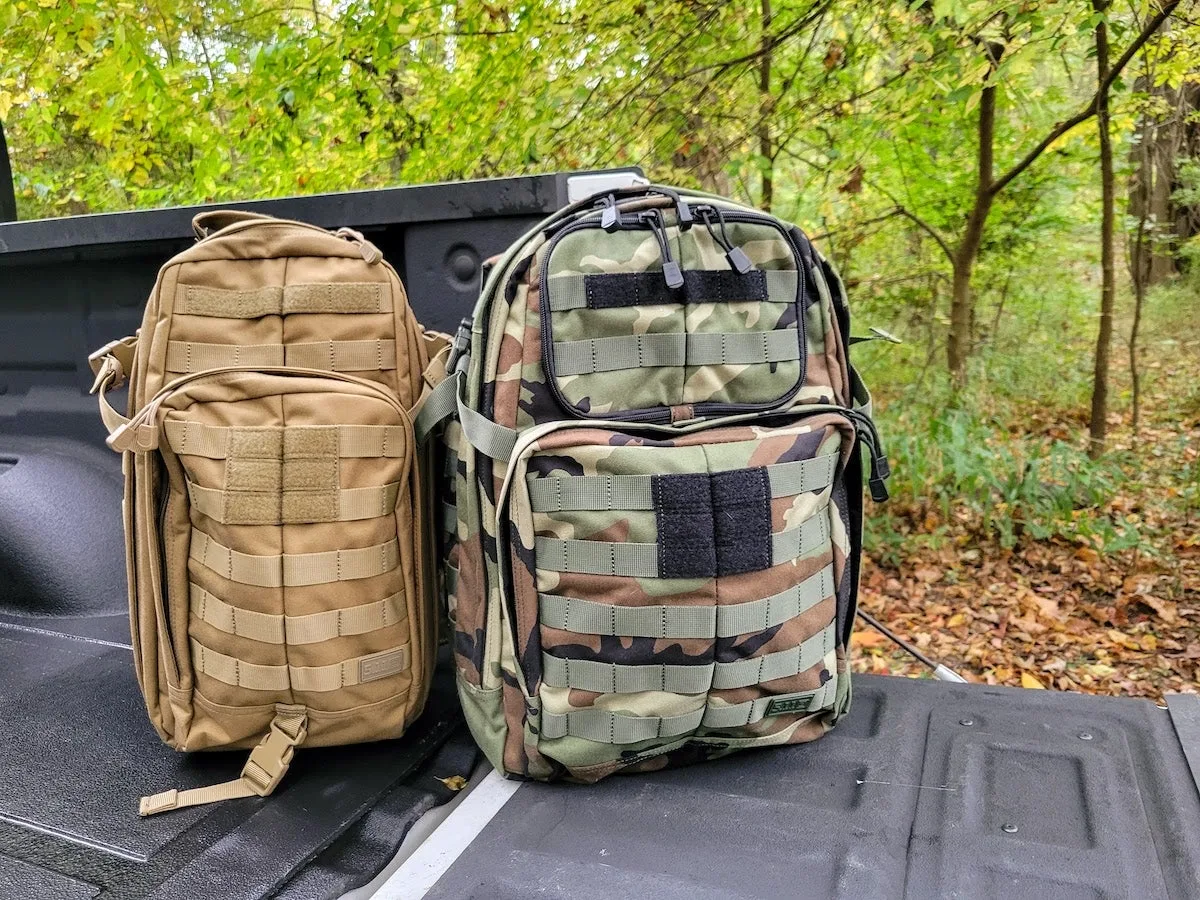
The good news is you don’t have to test out endless models to find one worth its salt. We’ve done the hard work for you, spending hours comparing pack specs and putting in our own miles out in the woods and through bustling downtown environments.
We selected the products on this list based mostly on previous testing and personal experience, although we also leaned heavily on product reputation and market research.
Best Overall: 5.11 Rush 24 2.0
Pros
So. Many. Pockets
Available in a variety of sizes
Super durable
Cons
Heavy
I am a bit of a backpack junkie. I collect them like many gals collect shoes, meaning I have a wide array of backpacks suitable for pretty much every occasion. (I admittedly haven’t found the right one for black tie occasions, but properly accessorizing a backpack with an evening gown is tricky.)
Of all the bags in my closet, the 5.11 Rush 72 2.0 is my all-time favorite. I carried it on a backpacking trip to Colorado’s White River National Forest, where it proved its mettle in a wilderness setting. I’ve also used it as a travel carry-on, where it helped me survive long plane rides and last-minute sprints through busy airports to catch a flight. This pack rocked out both situations—and I imagine it would be a great hunting backpack, too.
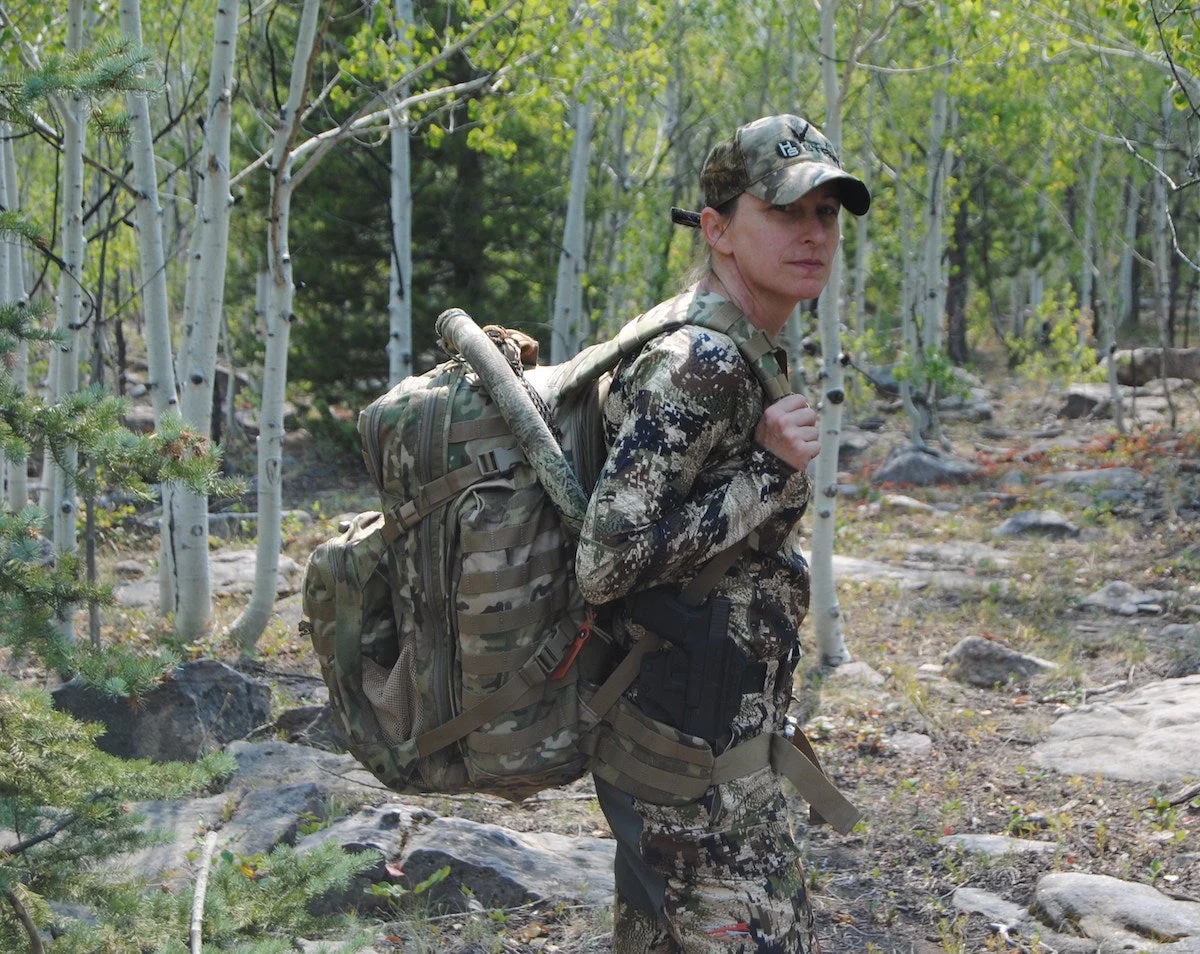
5.11 is one of the best backpack brands around. The 5.11 Rush series comes in three sizes: the smallest 37-liter Rush 24 and the ample 60-liter Rush 100, with the 55-liter Rush 72 sitting right in the middle. All of them are made from rugged, heavyweight 1050D nylon. These bags can take almost anything you or the apocalypse could dish out.
The only drawback to the super-sturdy construction is that the bags run heavy. They can put a hurting on your back when the packs are fully loaded, or you have to haul them long miles over rough terrain. The contoured yoke padded shoulder straps, waist belt, and reinforced back panel attempt to ease the burden, but these bags aren’t the best choice for backcountry backpacking. If that’s your plan, you may want to opt for something more lightweight.
All of the Rush series bags are absolutely loaded with pockets. The Rush 72 has a padded laptop sleeve and three zippered pockets in the main compartment, a top zippered pocket with another internal pocket, a fleece-lined eyewear pocket, dual side zippered pockets, a rear compartment for a water bladder, and a separate front compartment outfitted with even more internal pockets.
The exterior is also laced with plenty of MOLLE webbing so you can tack on all the extra compartments your sweet little prepper heart desires. With this backpack, there’s simply no excuse for your gear to be unorganized.
Our executive editor of commerce, Amanda Oliver, is also a big fan. She owns the Rush 24, and likes the rugged design and more portable size. Despite the fact that it’s the smallest of the Rush series, it has a surprisingly roomy interior with more than enough space for all of her emergency essentials. She’s carried it on multiple day-long hikes and a few hunts, and has found it stands up to a lot of abuse.
Specs
Dimensions: 22 x 13.4 x 10.25 inches
Capacity: 55 liters
Weight: 5 lbs 5 oz
Material: 1050D Nylon
Pockets: 15
Most Durable: Mystery Ranch Blitz 30
Pros
Full horseshoe-style zip
Plenty of pockets
Adjustable torso length
Cons
The back has only minimal padding
The Mystery Ranch Blitz 30 performs like a combat backpack that can withstand day-in-and-day-out abuse. It’s made from sturdy, weather-resistant 500D Cordura fabric and features coated YYK zippers. It makes a great emergency go-bag but is sturdy enough for regular abuse as an EDC bag, even if your everyday carry takes you into harsh environments.
The main compartment has a full horseshoe zip, which provides wide access. It’s a handy feature if you need to pack bulky gear. The Blitz 30 also features side and lower compression straps, allowing you to strap on whatever extras you need to carry along.
This thing is a water hauler. Not only does it have a spot for a bladder reservoir, but it also has three internal water bottle pockets. The side pockets are also the perfect size for toting water bottles, and they’re outfitted with grommeted drain holes, so you never have to deal with soggy pockets.
Specs
Dimensions: 20.5 x 13 x 13.5 inches
Capacity: 30 liters
Weight: 3 lbs 13 oz
Material: 500D Cordura fabric
Pockets: 9
Best Small Pack: 5.11 Rush MOAB Sling Pack
Pros
Compact size
Hidden concealment compartment with loop facing for a sticky holster
Ambidextrous shoulder strap
Integrates with other 5.11 packs
Cons
Single strap can feel unstable, especially when running
When it comes to small and compact survival packs, the 5.11 MOAB (Mobile Operation Attachment Bag) sling packs are about as petite as they come. The MOAB comes in three sizes ranging from 11 to 18 liters and four different colors to suit your individual survival needs.
Don’t be fooled by this bag’s compact size. There’s tons of organizational space in this one. The front compartment has a zip pocket and an admin section for pens or flashlights. It also has a concealed center compartment for securing sensitive cargo, such as an EDC pistol. Rounding out its storage features are a fleece-lined quick-access pocket and a hydration-ready compartment with a pass-through port. And if that isn’t enough to fill your needs, it also has MOLLE webbing all over the place so that you can attach even more goodies.
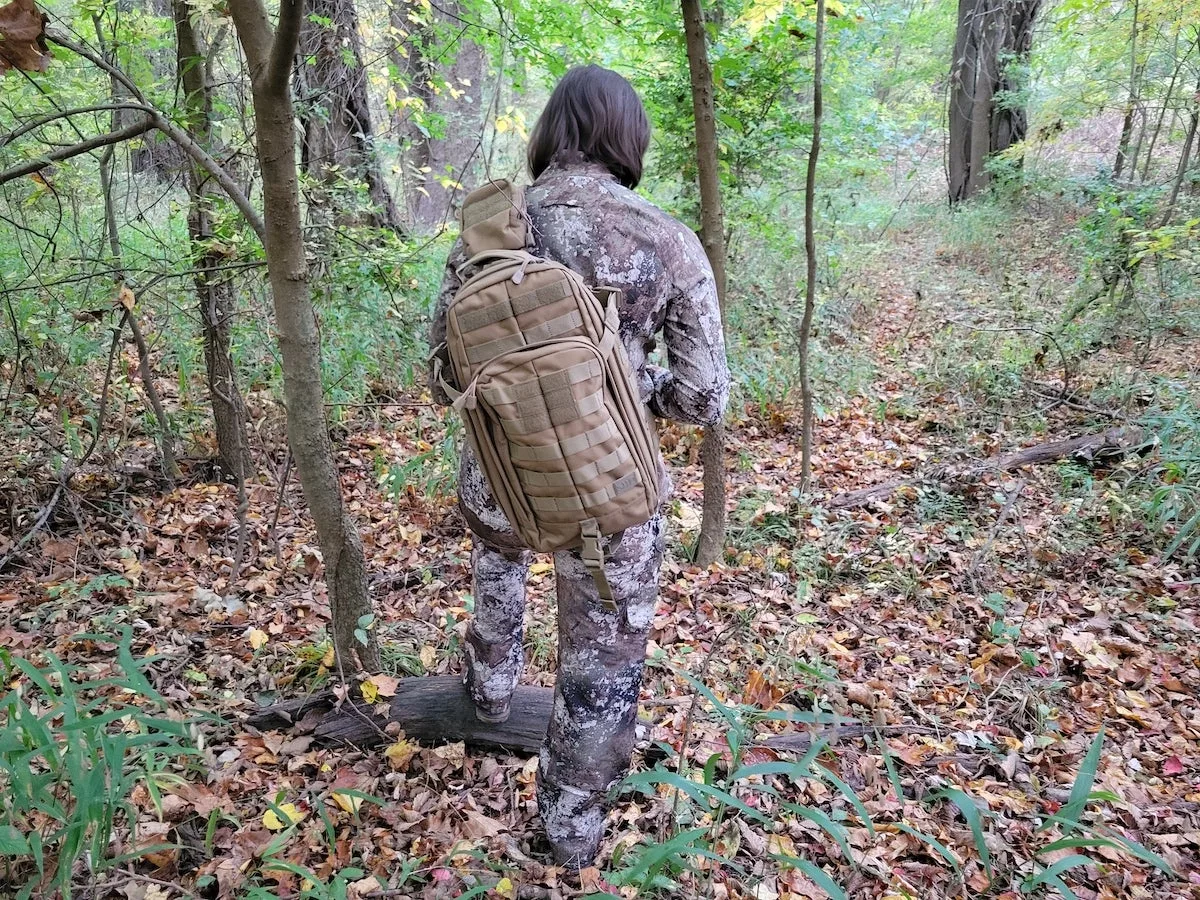
These bags have a unique, one-strap, sling-it-over-your-shoulder-and-go design that I absolutely love. They also attach to any of 5.11’s backpacks via the Rush tier system, which is perfect for those days when I need to carry all the things.
Specs
Dimensions: 10.5 x 9 x 5 inches; 16 x 8 x 7 inches; 18.25 x 9 x 7.25 inches
Capacity: 11 liters; 13 liters; 18 liters
Weight: 2 lbs; 2 lbs 6 oz; 2 lbs 10 ounces
Material: 1050D Nylon
Pockets: 9
Best Large Pack: Osprey Atmos AG 65
Pros
Antigravity Suspension
Integrated rain cover
Lightweight and durable construction
Plenty of storage space for multi-day use
Cons
Expensive
Osprey is a well-known brand in the outdoor world with a reputation for making best-in-class backpacks. The Atmos AG 65 is a lightweight technical backpack designed for multi-day hiking trips. Its features make it well-suited for recreational hiking and ideal as a survival pack, especially if the apocalypse leaves you hiking deep into the backcountry.

The pack is jam-packed with high-end features like the patented Antigravity suspension system that envelopes your back and hips in suspended mesh. It also has extra padding in the lumbar zone, which adds grip for comfortable load transfer. If you have to haul a bunch of heavy gear, this bag is designed to make you forget just how much weight you’re carrying.

The pack is also surprisingly lightweight for its size. However, Osprey didn’t cut any durability corners in their efforts to keep the bag’s weight manageable. The Atmos AG 65 is made from recycled 210D nylon. The bottom is constructed from tougher 500D high-tenacity nylon for extra ruggedness where it counts.
Specs
Dimensions: 32.68 x 15.35 x 14.17 inches
Capacity: 65 liters
Weight: 4 lbs 10 oz
Material: Recycled 210D honeycomb nylon with PFC-free DWR coating
Pockets: 9
Best Waterproof: Matador SEG45 Travel Pack
Pros
Carry-on compliant
Segmented design is perfect for organizing survival gear
High-quality zippers
Rugged design
Cons
Uncomfortable straps
Made from 420 DenierPU, this bag is already plenty durable. However, Matador took it one step further by adding a DWR water-repellent coating to repel moisture. The sturdy YKK zippers are also surrounded by 210D nylon bonded thread with bartack reinforcement to help seal out rain, snow, and dampness to keep your survival supplies dry in any kind of weather.
Matador also added reflective material around the zippers for added visibility, which is a bonus if you’re trying to draw attention for rescue teams but can be a major drawback if you’re trying to stay covert.
The Matador SEG45 Travel storage area is divided into sections, providing a great way to keep all your survivalist supplies organized. The segments open individually to allow for easy access to snacks, clean underwear, or a first aid kit without rifling through all of the bag’s contents.
One of the best things about this bag is its versatility. It can work as a duffel bag or a backpack, making it an excellent option for traveling, whether through a bustling airport or out into the woods. However, the straps on this one aren’t the most comfortable straps I’ve ever found on a backpack. A little more padding would go a long way in improving comfort if you need to tote this one a long way.
Specs
Dimensions: 22 x 13.4 x 10.25 inches
Capacity: 45 liters
Weight: 2 lbs 8 oz
Material: 420 DenierPU and DWR-coated nylon
Pockets: 9
Best With Extra Compartments: Kelty Tactical Raven 2500
Pros
Perfect for use with a satellite radio
Plenty of pockets and dividers to organize your gear
Lots of load compression straps
MOLLE on front and side pockets
Rain cover
Cons
Very heavy
The Kelty Raven 2500 is built for communication gurus. It accommodates a variety of antennas and fits most satellite radios, plus enough gear for an extended stay in the field. It has a suspension system that holds Harris 117 radios (and other similarly sized models) in place so you can use the radio while you’re on the move. The pack even comes with Kelty’s radio and battery holders.
If you want storage compartments, this backpack is a dream come true. The Raven 2500 features two zippered side pockets, two side-shove pockets, a shovel pocket, a reservoir sleeve and hydration port, a security pocket, mesh dividers, and so many internal pockets that I lost count. The bag also has a vertical compression strap and four side compression straps to help keep your load as compact as possible.
The heavy-duty construction combined with so many storage pockets makes this backpack a real heavyweight. It weighs almost 7 pounds before you load a single piece of survival gear. Kelty tried to make managing the load somewhat easier by including adjustable suspension, a breathable back panel, load lifter straps, and a padded waistbelt in the design. However, you may still feel like a pack mule if you have to cover any distance.
Specs
Dimensions: 22 x 19 x 14 inches
Capacity: 41 liters
Weight: 6 lbs 13 oz
Material: 500D nylon and 1000D nylon
Pockets: Too many to count
Most Functional: Deuter Futura Pro 36
Pros
Designed for comfort
Integrated rain cover
Durable fabric
Lightweight for its size
Cons
Main compartment is top load only
Despite the survival community’s apparent penchant for tactical military-style bags, there’s no rule book that says your survival backpack has to be tricked out in MOLLE or multi-cam. Tactical backpacks tend to run heavy. If you want something ergonomic and easy on the back, a hiking backpack is probably the wiser choice, especially since chiropractors rarely practice in the backcountry or during apocalyptic societal collapse.
Deuter is a well-respected backpack brand in the outdoor industry, and although their bags are engineered for recreational purposes, they also function well as survival backpacks. The Futura Pro is one of the company’s bestsellers, and it is packed with top-tier comfort features, including moveable hip fins with padded inserts and an ergonomic mesh back for maximum ventilation.
This backpack boasts plenty of compartments for organizing your gear. In addition to the roomy main compartment, it has extra storage pockets in the lid, base, and hip belt, as well as two spacious side bellow pockets. The only real drawback to the organizational design is that the massive main compartment is only accessible from the top. It can take some digging to get to gear at the bottom.
Deuter also makes a version of this bag for women. The Futura Pro 34 SL has a shorter carrying system specially adapted for female anatomy.
Specs
Dimensions: 24 x 12.6 x 9.5 inches
Capacity: 36 liters
Weight: 3 lbs 7 oz
Material: 600 denier polyester with a PU coating
Pockets: 6
What to Look For in a Survival Backpack
Capacity
When it comes to how much a bag can hold, backpacks pretty much run the gamut, ranging in size from a measly 10 liters up to 70 liters or more. While it’s tempting to think bigger is better, larger-capacity backpacks can be bulky, heavy, and a literal pain to carry. You really only need a bag big enough to hold ample supplies to see you through an emergency.
For most people, a 20- or 30-liter pack will carry enough supplies for 24 hours, while 45 liters will see you through two days and 55 liters is large enough to hold a 3-day supply kit.
Size and Comfort
In some survival situations, you could spend considerable time wearing a fully loaded backpack. The more time you spend toting your pack, the more size and comfort become a priority.
Size and comfort are highly personal. A 5-foot-3 female will demand a significantly different fit and feel than her 6-foot-2 male companion. Many high-quality packs are available in several sizes, find a pack that matches your torso length for maximum comfort.
Other comfort features may not seem like a big deal on the showroom floor but become invaluable once you’re in the thick of things. Adjustable padded chest, hip, and shoulder straps and built-in lumbar support will quickly become your best friend if you have to haul a heavy pack for multiple days.
Organization
A good backpack should have plenty of pockets and compartments for stowing your stuff. Multiple pockets will not only help keep your toothpaste from mingling with your extra batteries, but separate compartments will also help you find things more easily.
FAQs
Q: What type of backpack is best for survival?
The best type of backpack for survival depends on the environment you’re preparing to tackle. If you’re headed miles off the blacktop into the remote backcountry, an internal frame backpack will help you efficiently carry the weight of your survival gear deep into the wilderness.
However, if your idea of a survival situation involves bugging out in an urban setting, something smaller and more covert may be more appropriate to keep you from standing out in a crowd.
Q: What should you put in a survival backpack?
While the exact supplies you should pack in your survival backpack vary based on personal needs and the situation you’re facing, Ready.gov has a list of basic disaster supplies everyone should keep in their kit. The list includes essential items such as:
WaterFoodBattery-powered or hand crank radio and a NOAA Weather Radio with tone alertFlashlightFirst aid kitExtra batteriesDust maskPlastic sheeting and duct tapeMoist towelettes, garbage bags, and plastic tiesWrench or pliersLocal mapsCell phone with chargers and a backup battery
Q: How do you pack a survival backpack?
As a general rule, when packing any backpack, heavy items should ride in the middle of the pack and as close to your back as possible. However, in a survival situation, it may be more important to pack essential items where you can get to them quickly. If you don’t need to traverse long distances, packing for accessibility may need to trump packing for optimal weight distribution.
What Is the Best Survival Backpack?
Best Overall: 5.11 Rush 24 2.0
Most Durable: Mystery Ranch Blitz 30
Best Small Pack: 5.11 Rush MOAB Sling Pack
Best Large Pack: Osprey Atmos AG 65
Best Waterproof: Matador SEG45 Travel Pack
Best With Extra Compartments: Kelty Tactical Raven 2500
Most Functional: Deuter Futura Pro 36
There really is no one-size-fits-all solution for survival. While survival backpacks don’t all look the same, they have one thing in common: you should have one.
Why Trust Us
For more than 125 years, Field & Stream has been providing readers with honest and authentic coverage of outdoor gear. Our writers and editors eat, sleep, and breathe the outdoors, and that passion comes through in our product reviews. You can count on F&S to keep you up to date on the best new gear. And when we write about a product—whether it’s a bass lure or a backpack—we cover the good and the bad, so you know exactly what to expect before you decide to make a purchase.

